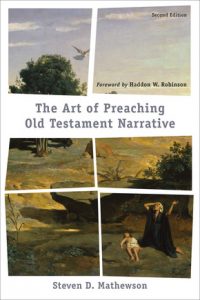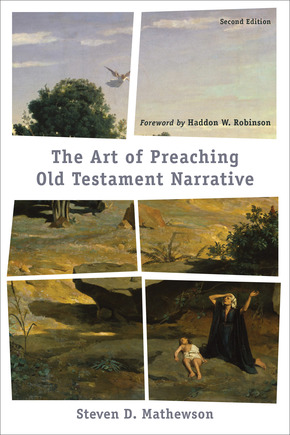Mathewson, Steven D. The Art of Preaching Old Testament Narrative. 2nd edition. Grand Rapids, MI: Baker Academic, 2021, 252 pages, $22.99, paperback.
Steven Mathewson is both a pastor and a scholar. He serves as the senior pastor in Libertyville, IL, and he is also the director of the Doctor of Ministry program at Western Seminary in Portland, OR. Mathewson’s background as a practitioner and scholar in the field of homiletics enhances his book, The Art of Preaching Old Testament Narrative, by allowing him to provide practical counsel and helpful instruction to readers.
The author develops his work around three parts. In Part One, Mathewson addresses some challenges with preaching from Old Testament narratives, and he surveys “The Christ-Centered Preaching Debate” (pp. 15-26). In relation to the subject of Christ-centered preaching, the author notes that “I did not deal with this sufficiently (in fact, hardly at all) in his first edition” (xviii). Mathewson’s rationale for adding this discussion is as follows: “Your conclusions [about preaching Christ in the Old Testament] will shape the way that you study and preach an Old Testament narrative text” (p.15).
In Part Two, Mathewson presents his methodology for studying biblical narratives for preaching in six chapters. The first chapter addresses key aspects of sermon preparation such as text selection (pp. 29-32), exegesis (pp. 32-39) and prayer (pp. 39-40). Beginning with the second chapter in Part Two, the author works systematically through his exegetical methodology for preaching Old Testament narratives, and he employs the acronym “ACTS” (p. 41) to describe its main components. The “A” in “ACTS” stands for “Action” and corresponds to the literary feature of plot in biblical narratives (p. 41). This discussion culminates in the practical benefit of developing an exegetical outline for preaching a biblical narrative. The next chapter explains that the “C” in the acronym “ACTS” stands for “characters” (p. 65). The fourth chapter in Part Two discusses the “T” in the word “ACTS” which is the initial for the word “talking” (p. 75). While readers may assume that Mathewson focuses on the words or speeches of characters in this chapter, the author actually uses the word “talking” in a broader sense to “focus on the statements or speeches made by characters – as well as editorial insights shared by the narrator” (p. 75). In the fifth chapter of this section of the book, the “S” in the word “ACTS” comes into view, and it stands for “setting” (p. 81). Again, the word “setting” is used in a rather broad sense to cover ideas such as “Historical-Cultural Setting” (pp. 82-83) and “Literary Setting” (pp. 83-85). Part Two of the book concludes with practical pointers on how to summarize key information gleaned from the application of the “ACTS” methodology (pp. 87-90), and it also includes a homiletical discussion on how to formulate a “Big Idea” from a biblical narrative (pp. 90-96).
Part Three of The Art of Preaching Old Testament Narrative focuses on homiletics in terms of building upon the exegetical foundation and literary analysis discussed in Part Two. The first chapter in this closing section of the book addresses the topics of connecting the focal narrative to the overarching storyline of Scripture (pp. 108-111) as well as “Explanation” (pp. 111-112), “Validation” (pp. 112-113), and “Application” (pp. 113-119). The second chapter in Part Three returns to the homiletical subject of the “Big Idea” (pp. 121-124) mentioned earlier in the book as well as briefly discusses the purpose of the sermon (pp. 125-126). The third chapter in this section proposes different types of movement which may be used in developing a sermon on biblical narratives. The major options discussed are “Inductive Preaching” (pp. 128-133), “The Flashback Approach” (p. 133), “The Inductive-Deductive Approach” (133-134), “The Semi-inductive Approach” (p. 134), and “First-Person Narratives” (134-136). The final four chapters in Part Three offer homiletical counsel on topics like developing a sermon outline (pp. 137-135), developing a sermon manuscript (pp. 165-163), developing an introduction and conclusion (pp. 165-170), and delivering a sermon (pp. 171-177), respectively.
In addition to a helpful bibliography, Scripture index, and subject index, The Art of Preaching Old Testament Narrative includes three appendices which further enhance its benefits. Appendix A features a sample sermon manuscript on Judges 17-18. This sample sermon is intended to illustrate the methodology for preaching biblical narratives discussed throughout the book, and after the sample sermon, Mathewson provides some analysis of his sample sermon as well as an outline for the sermon manuscript. It should be noted that while the second edition only includes one sample sermon in contrast to the first edition which included five sample sermons (p. xviii), the author directs readers to other publications where more sample sermons can be found (p. 179). Appendix B focuses on applying the exegetical methodology in the book to the Hebrew text more directly. This discussion should be helpful for readers with a proficiency with the Hebrew language. Lastly, Appendix C offers readers guidance on commentaries on select biblical books.
Both practitioners and scholars should find The Art of Preaching Old Testament Narrative helpful. The layout of the book provides a guide for preachers to develop sermons based on biblical narratives in terms of how their sermons align with the biblical content and flow of Old Testament narratives. Of course, the exegetical and homiletical principles discussed in the book are also transferrable to preaching narrative texts in the New Testament.
In terms of challenges with the resource, they are few in number, but three are worth mentioning. To begin, the chapter added to the second edition entitled “The Christ-Centered Preaching Debate” (pp. 15-26) is an important addition. However, it is more of a historical survey of the debate. Readers who are unfamiliar with the nuances, arguments, and approaches in this debate will need to make additional effort to read the homileticians referenced in this chapter in order to arrive at a more robust understanding of the hermeneutical and homiletical issues involved in this discussion. Second, some of the homiletical topics mentioned in the book assume some prior knowledge. For example, while the subject of “Big Idea” preaching surfaces in more than one place in the book, the discussions of this homiletical concept are brief. Readers would be well served to follow the author’s footnotes in these sections of the book to read more extensively on these topics. This general idea would also apply to other aspects of the resource related to the various functional elements of preaching like explanation, illustration, and application, for instance. Lastly, while the survey of commentaries in the final appendix is helpful, it is nevertheless truncated. For instance, this appendix only covers the Pentateuch and the historical books. It does not provide guidance for other biblical books which also include narrative sections such the books of Jeremiah, Hosea, and Jonah. While these are prophetic books, they nevertheless include narrative aspects, and offering some hermeneutical and homiletical guidance for prophetic narratives would be helpful.
Even with these challenges, The Art of Preaching Old Testament Narrative is a solid resource for all readers who are interested in developing sermons based on biblical narratives. The overall methodology presented in the book along with its helpful appendices and bibliography will provide practitioners and scholars with guidance for a sustained and meaningful journey in learning to preach Old Testament narratives well.
Pete Charpentier
Grand Canyon Theological Seminary





